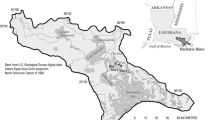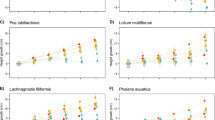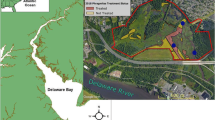Abstract
Many streams that were channelized to facilitate timber floating in northern Sweden, have in recent years been restored by returning coarse sediment (cobbles and boulders) to the channel and reconnecting riparian with instream habitats. We asked if such restoration measures affect germination and survival of plants in the riparian zone, and if such potential effects depend on location in the catchment. We used a paired site approach, comparing the performance of Helianthus annuus (sunflower) phytometers (seeds and seedlings) in the riparian zone in channelized versus restored river reaches along climate and stream size gradients in the Vindel River catchment in northern Sweden. Phytometer survival, substrate availability, and soil nutrient content in large streams were enhanced by restoration, but overall, phytometer performance was negatively related to the length of the growing season, i.e. phytometers grew best at high altitudes and short growing seasons. This result may have been caused by less competition from the shorter and sparser neighbouring vegetation at these sites or to more frequent flooding events, enhancing retention of organic matter. Soil nutrient levels were lowest close to the coast and in large streams, probably due to deposition of mineral sediment. The higher availability of riparian habitat at restored than at channelized sites suggests that plant species richness and abundance may potentially increase after restoration. Seedling transplantation seems to be a preferable revegetation measure, because phytometer seedlings established better than seeds and survival was significantly higher at restored sites. The good plant performance at sites with short growing seasons and high altitudes suggests that, with limited resources, restoration measures should first be located to such sites.




Similar content being viewed by others
References
Andersson E, Nilsson C, Johansson ME (2000) Plant dispersal in boreal rivers and its relation to the diversity of riparian flora. J Biogeogr 27:1095–1106
Ångström A (1974) Sveriges klimat, 3rd edn. Generalstabens Litografiska Anstalts Förlag, Stockholm
Arthington AH, Bunn SE, Poff NL, Naiman RJ (2006) The challenge of providing environmental flow rules to sustain river ecosystems. Ecol Appl 16:1311–1318
Bakker ES, Sarneel JM, Gulati RD, Lui Z, van Donk E (2012) Restoring macrophyte diversity in shallow temperate lakes: biotic versus abiotic constraints. Hydrobiologia 710:23–37
Balke T, Herman PMJ, Bouma TJ (2014) Critical transitions in disturbance-driven ecosystems: identifying Windows of Opportunity for recovery. J Ecol 102:700–708
Bejarano MD, Marchamalo M, Garcia de Jalon D (2010) Flow regime patterns and their controlling factors in the Ebro basin (Spain). J Hydrol 385:323–335
Bernhardt ES, Palmer MA, Allan JD, Alexander G, Barnas K, Brooks S, Carr J, Clayton S, Dahm C, Follstad-Shah J, Galat D, Gloss S, Goodwin P, Hart D, Hassett B, Jenkinson R, Katz S, Kondolf GM, Lake PS, Lave R, Meyer JL, O’Donnell TK, Pagano L, Powell B, Sudduth E (2005) Ecology: synthesizing US river restoration efforts. Science 308:636–637
Brookes A (1997) Restoring the sinuosity of artificially straightened stream channels. Environ Geol Water Sci 10:33–41
Burmeier S, Eckstein RL, Otte A, Donath TW (2010) Desiccation cracks act as natural seed traps in flood–meadow systems. Plant Soil 333:351–364
Catford JA, Daehler CC, Murphy HT, Sheppard AW, Hardesty BD, Westcott DA, Rejmánek M, Bellingham PJ, Pergl J, Horvitz CC, Hulme PE (2012) The intermediate disturbance hypothesis and plant invasions: implications for species richness and management. Perspect Plant Ecol 14:231–241
Clements FE, Goldsmith GW (1924) The phytometer method in ecology: the plant and community as instruments. Carnegie Institution, Washington, DC
Dietrich AL, Nilsson C, Jansson R (2013) Phytometers are underutilised for evaluating ecological restoration. Basic Appl Ecol 14:369–377
Dietrich AL, Lind L, Nilsson C, Jansson R (2014) The use of phytometers for evaluating restoration effects on riparian soil fertility. J Environ Qual 43:1916–1925
Dudgeon D, Arthington AH, Gessner MO, Kawabata ZI, Knowler DJ, Leveque C, Naiman RJ, Prieur-Richard AH, Soto D, Stiassny MLJ, Sullivan CA (2006) Freshwater biodiversity: importance, threats, status and conservation challenges. Biol Rev 81:163–182
European Commission (2000) Directive 2000/60/EC of the European Parliament and of the Council of October the 23rd Establishing a Framework for Community Action in the Field of Water Policy. Official Journal of the European Communities, Brussels
Feld CK, Birk S, Bradley DC, Hering D, Kail J, Marzin A, Melcher A, Nemitz D, Pedersen ML, Pletterbauer F, Pont D, Verdonschot PFM, Friberg N (2011) From natural to degraded rivers and back again: a test of restoration ecology theory and practice. Adv Ecol Res 44:119–209
Florsheim JL, Mount JF, Chin A (2008) Bank erosion as a desirable attribute of rivers. Bioscience 58:519–529
Gardeström J, Holmqvist D, Polvi LE, Nilsson C (2013) Demonstration restoration measures in tributaries of the Vindel River catchment. Ecol Soc 18(3):8. doi:10.5751/ES-05609-180308
Geurts JJM, van de Wouw PAG, Smolders AJP, Roelofs JGM, Lamers LPM (2011) Ecological restoration on former agricultural soils: feasibility of in situ phosphate fixation as an alternative to top soil removal. Ecol Eng 37:1620–1629
Gibson DJ (2002) Methods in comparative plant population ecology. Oxford University Press, Oxford
Hald AB, Nielsen AL, Debosz K, Badsberg JH (2003) Restoration of degraded low-lying grasslands: indicators of the environmental potential of botanical nature quality. Ecol Eng 21:1–20
Hart DD, Johnson TE, Bushaw-Newton KL, Horwitz RJ, Bednarek AT, Charles DF, Kreeger DA, Velinsky DJ (2002) Dam removal: challenges and opportunities for ecological research and river restoration. Bioscience 52:669–681
Helfield JM, Capon SJ, Nilsson C, Jansson R, Palm D (2007) Restoration of rivers used for timber floating: effects on riparian plant diversity. Ecol Appl 17:840–851
Helfield JM, Engström J, Michel JT, Nilsson C, Jansson R (2012) Effects of river restoration on riparian biodiversity in secondary channels of the Pite River, Sweden. Environ Manag 49:130–141
Hoffmann WA, Poorter H (2002) Avoiding bias in calculations of relative growth rate. Ann Bot 90:37–42
Hough-Snee N, Roper BB, Wheaton JM, Budy P, Lokteff RL (2013) Riparian vegetation communities change rapidly following passive restoration at a northern Utah stream. Ecol Eng 58:371–377
Isselstein J, Tallowin JRB, Smith REN (2002) Factors affecting seed germination and seedling establishment of fen-meadow species. Restor Ecol 10:173–184
Iversen TM, Kronvang B, Madsen BL, Markmann P, Nielsen MB (1993) Reestablishment of Danish streams: restoration and maintenance measures. Aquat Conserv 3:73–92
Kaase CT, Kat GK (2012) Effects of stream restoration on woody riparian vegetation of southern Appalachian Mountain streams, North Carolina, U.S.A. Restor Ecol 20:647–655
Kauffman JB, Beschta RL, Otting N, Lytjen D (1997) An ecological perspective of riparian and stream restoration in the Western United States. Fisheries 22:12–24
Ladefoged TN, Stevenson CM, Haoa S, Mulrooney M, Pulestone C, Vitousek PM, Chadwick OA (2010) Soil nutrient analysis of Rapa Nui gardening. Archaeol Ocean 45:80–85
Leicht-Young SA, Silander JA Jr, Latimer AM (2007) Comparative performance of invasive and native Celastrus species across environmental gradients. Oecologia 154:273–282
Lennox MS, Lewis DJ, Jackson RD, Harper J, Larson S, Tate KW (2011) Development of vegetation and aquatic habitat in restored riparian sites of California’s north coast rangelands. Restor Ecol 19:225–233
Maddock I (1999) The importance of physical habitat assessment for evaluating river health. Freshw Biol 41:373–391
Malmqvist B, Rundle S (2002) Threats to the running water ecosystems of the world. Environ Conserv 29:134–153
Meyer CK, Whiles MR, Baer SG (2010) Plant community recovery following restoration in temporally variable riparian wetlands. Restor Ecol 18:52–64
Muotka T, Syrjänen J (2007) Changes in habitat structure, benthic invertebrate diversity, trout populations and ecosystem processes in restored forest streams: a boreal perspective. Freshw Biol 52:724–737
Naiman RJ, Décamps H, Pollock M (1993) The role of riparian corridors in maintaining regional biodiversity. Ecol Appl 3:209–212
Naiman RJ, Bunn SE, Nilsson C, Petts GE, Pinay G, Thompson LC (2002) Legitimizing fluvial ecosystems as users of water: an overview. Environ Manag 30:455–467
Nakamura F, Ishiyama N, Sueyoshi M, Negishi JN, Akasaka T (2014) The significance of meander restoration for the hydrogeomorphology and recovery of wetland organisms in the Kushiro River, a lowland river in Japan. Restor Ecol 22:544–554
Nilsson C, Ekblad A, Dynesius M, Backe S, Gardfjell M, Carlberg B, Hellqvist S, Jansson R (1994) A comparison of species richness and traits of riparian plants between a main river channel and its tributaries. J Ecol 82:281–295
Nilsson C, Lepori F, Malmqvist B, Törnlund E, Hjerdt N, Helfield JM, Palm D, Östergren J, Jansson R, Brännäs E, Lundqvist H (2005a) Forecasting environmental responses to restoration of rivers used as log floatways: an interdisciplinary challenge. Ecosystems 8:779–800
Nilsson C, Reidy CA, Dynesius M, Revenga C (2005b) Fragmentation and flow regulation of the world’s large river systems. Science 308:405–408
Nilsson C, Brown RL, Jansson R, Merritt DM (2010) The role of hydrochory in structuring riparian and wetland vegetation. Biol Rev 85:837–858
Nilsson C, Polvi LE, Gardeström J, Hasselquist EM, Lind L, Sarneel J (2015) Riparian and instream restoration of boreal streams and rivers: success or failure? Ecohydrology (in press)
O’Dowd DJ, Gill AM (1984) Predator satiation and site alteration following fire: mass reproduction of alpine ash (Eucalyptus delegatensis) in southeastern Australia. Ecology 65:1052–1066
Palmer MA, Bernhardt ES, Allan JD, Lake PS, Alexander G, Brooks S, Carr J, Clayton S, Dahm CN, Shah JF, Galat DL, Loss SG, Goodwin P, Hart DD, Hassett B, Jenkinson R, Kondolf GM, Lave R, Meyer JL, O’Donnell TK, Pagano L, Sudduth E (2005) Standards for ecologically successful river restoration. J Appl Ecol 42:208–217
Palmer MA, Filoso S, Fanelli RM (2014) From ecosystems to ecosystem services: stream restoration as ecological engineering. Ecol Eng 65:62–70
Poff NL, Matthews JH (2013) Environmental flows in the Anthropocene: past progress and future prospects. Curr Opin Environ Sustain 5:667–675
R Development Core Team (2011) R: a language and environment for statistical computing. The R Foundation for Statistical Computing, Vienna. http://www.R-project.org/. Accessed 20 Jan 2015
Renöfält BM, Jansson R, Nilsson C (2005) Spatial patterns of plant invasiveness in a riparian corridor. Landsc Ecol 20:165–176
Ruwanza S, Gaertner M, Esler KJ, Richardson DM (2013) Both complete clearing and thinning of invasive trees lead to short-term recovery of native riparian vegetation in the Western Cape, South Africa. Appl Veg Sci 16:193–204
Sanders S, McGraw JB (2005) Hydrastis canadensis L. (Ranunculaceae) distribution does not reflect response to microclimate gradients across a mesophytic forest cove. Plant Ecol 181:279–288
SER (2004) The SER international primer on ecological restoration. Society for Ecological Restoration International, Science and Policy Working Group. http://www.ser.org/docs/default-document-library/english.pdf. Accessed 20 Jan 2015
Stanford JA, Ward JV, Liss WJ, Frissell CA, Williams RN, Lichatowich JA, Coutant CC (1995) A general protocol for restoration of regulated rivers. Regul Rivers Res Manag 12:391–413
Stanley EH, Doyle MW (2003) Trading off: the ecological effects of dam removal. Front Ecol Environ 1:15–22
Sudduth EB, Meyer JL, Bernhardt ES (2007) Stream restoration practices in the southeastern United States. Restor Ecol 15:573–583
Sundborg Å, Elfström Å, Rudberg S (1980) Piteälven, Laisälven och Vindelälven. Naturförhållanden och miljöeffekter vid vattenöverledning. UNGI Report No. 51. Uppsala University, Uppsala
Sundermann A, Stoll S, Haase P (2011) River restoration success depends on the species pool of the immediate surroundings. Ecol Appl 21:1962–1971
Sveriges Nationalatlas (1995) Klimat, sjöar och vattendrag. Bra Böcker, Höganäs
Tallowin JRB, Smith REN (2001) Restoration of a Cirsio–Molinietum fen meadow on an agriculturally improved pasture. Restor Ecol 9:167–178
Törnlund E, Östlund L (2002) Floating of timber in northern Sweden: the construction of floatways and transformation of rivers. Environ Hist 8:85–106
Tullos DD, Penrose DL, Jennings GD, Cope WG (2009) Analysis of functional traits in reconfigured channels: implications for the bioassessment and disturbance of river restoration. J N Am Benthol Soc 28:80–92
Van Loon AH, Soomers H, Schot PP, Bierkens MFP, Griffioen J, Wassen MJ (2011) Linking habitat suitability and seed dispersal model in order to analyze the effectiveness of hydrological fen restoration strategies. Biol Conserv 144:1025–1035
Vander Mijnsbrugge K, Bischoff A, Smith B (2010) A question of origin: where and how to collect seed for ecological restoration. Basic Appl Ecol 11:300–311
Violle C, Castro H, Richarte J, Navas ML (2009) Intraspecific seed trait variations and competition: passive or adaptive response? Funct Ecol 23:612–620
Wilcox AC, O’Connor JE, Major JJ (2014) Rapid reservoir erosion, hyperconcentrated flow, and downstream deposition triggered by breaching of 38 m tall Condit Dam, White Salmon River, Washington. J Geophys Res 119:1376–1394
Acknowledgments
We thank Javier Segura and Patrik Bylund for assistance in the field, Johan Rydberg for laboratory assistance and Lenka Kuglerová for statistical help and comments on the manuscript. Funding was provided by the Swedish Research Council Formas (to CN).
Author information
Authors and Affiliations
Corresponding author
Additional information
Communicated by Shayne Martin Jacobs.
Rights and permissions
About this article
Cite this article
Dietrich, A.L., Nilsson, C. & Jansson, R. Restoration effects on germination and survival of plants in the riparian zone: a phytometer study. Plant Ecol 216, 465–477 (2015). https://doi.org/10.1007/s11258-015-0450-3
Received:
Accepted:
Published:
Issue Date:
DOI: https://doi.org/10.1007/s11258-015-0450-3




